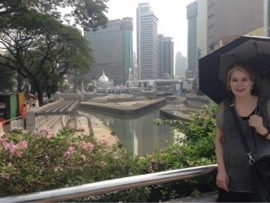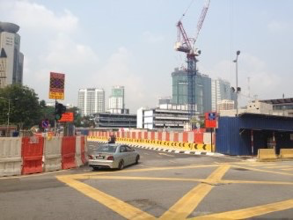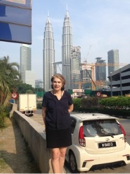Kuala Lumpur and Melaka, Malaysia
 The fourth stop in my trip around the world is Malaysia, landing in Kuala Lumpur.
The fourth stop in my trip around the world is Malaysia, landing in Kuala Lumpur.
The first thing you need to know is that kuala means ‘confluence of two rivers, estuary’ and lumpur means ‘muddy’. Here I am (in the photo on the right) at the muddy confluence. Note: Everywhere in Asia it is normal to carry a parasol.
The domed building in the background is a mosque. The Malaysian population is 60% Malay. The Malay are 100% Muslim. The rest areas on the highways have surau, that is, prayer rooms. The ceilings on hotels have green arrows to indicate the direction of Mecca.
Other ethnic groups include Chinese and Tamil (from South India). My driver, Krishnamurthi, is ethnic Tamil. He went to school in the local language, Malay. However, his daughter went to a Tamil school, and his son went to a Chinese school. At home they speak a mix of Tamil and English.
The next thing you need to know is that Kuala Lumpur is a mishmash of preserved colonial beauty, crumbly old, crummy semi-new (always concrete and always dirty) and up-to-the-minute sparkly glass and steel buildings.
Here’s the colonial-era railway station.

Around a few corners is the old town, which is not in the best repair, nor is it very clean. Colorful, yes!
Here’s the entrance to China Town, aka Knock-Off Land.

I loved hearing all about the history of the city and the country. Key modern moments: independence from Britain came in 1957, and Singapore separated from Malaysia in 1965.
In Malaysia they drive on the left-hand side of the road, a legacy of the British Empire. The English language is also a part of that legacy.
I saw billboards for three schools that fold English-language education into the Islamic faith: Little Caliphs, Greenview, and I Love Allah Montessori. (I did a double-take on the last one).
There is a sizable Tamil community, which means there are Hindu temples, such as this one in the heart of the old city. It had a beautiful interior.


A couple hundred feet away is a typical Kuala Lumpur intersection, namely a construction zone.
The Batu Caves are a tourist draw.


Monkeys abound,
I’ve long thought that the history of Western philosophy would have been a lot different if Europe had been a habitat for primates other than just humans. When the Greeks and Romans and French (and everyone else) looked around, they didn’t seem animals resembling humans, and so they built worldviews based on the supposed uniqueness of humans. It’s taken the last 150 since Darwin to undo some of these worldviews.
Here’s the sparkly new thing in town (no, not me), namely the Twin Towers. It is obligatory to have a picture taken in front of it (apparently – I could not decline the treat).
Then it’s on to Melaka, a former Portuguese and former Dutch port town on the Straits of Mallaca. When you enter town, you see this sign.

Uh, guys? The Don’t Mess With Texas slogan has an internal rhyme, and yours doesn’t. Furthermore, Krishnamurthi finds the sign arrogant. He does not accept the explanation that it’s an anti-litter campaign, because he says there are already signs in Malay for that.
Everywhere you go in Melaka, you see evidence of the Portuguese and the Dutch. Naturally there has to be a little windmill across the street from the church. Behind the windmill you dive into the touristy old town, a series of small streets that radiate off Jonker Street.

Charming local note: In the plantation system of banana production, one stalk flowers only once. Thus, banana plants have been traditionally used as decorations at Tamil weddings, to symbolize how the couple has only one marriage.

Krishnamurthi says, alas, the one marriage and traditional use of banana plants are a thing of the past.
See also: All My Asia Blogs
Categorised in: Adventure, East Asia
This post was written by Julie Tetel Andresen
You may also like these stories:
- google+
- comment





